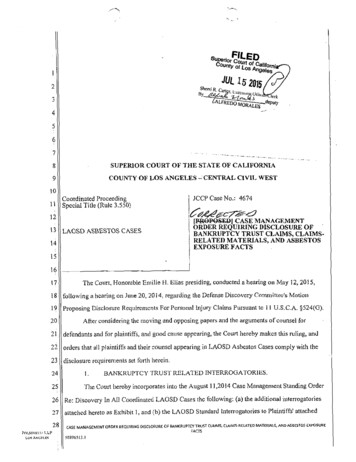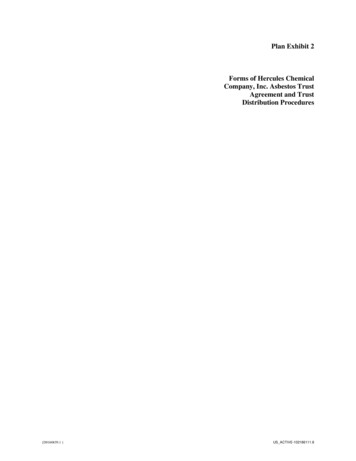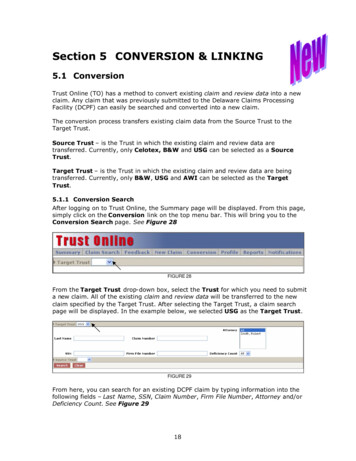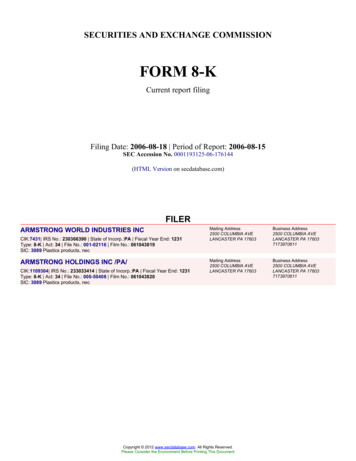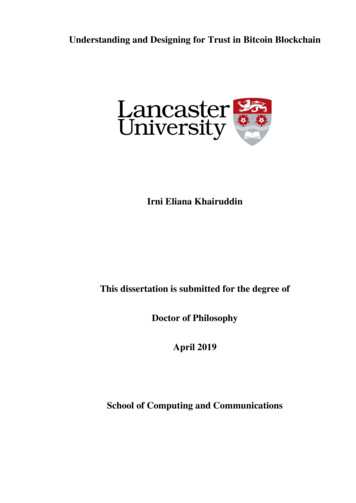
Transcription
Understanding and Designing for Trust in Bitcoin BlockchainIrni Eliana KhairuddinThis dissertation is submitted for the degree ofDoctor of PhilosophyApril 2019School of Computing and Communications
DeclarationThis thesis has not been submitted in support of an application for another degree at thisor any other university. It is the result of my own work and includes nothing that is theoutcome of work done in collaboration except where specifically indicated. Many of theideas in this thesis were the product of discussion with my supervisor Professor CorinaSas. The work in this thesis has not been published anywhere else except in the followingpublications:1. Corina Sas and Irni Eliana Khairuddin. 2015. Exploring Trust in Bitcoin Technology: AFramework for HCI Research. In Proceedings of the Annual Meeting of the AustralianSpecial Interest Group for Computer Human Interaction (OzCHI '15), Bernd Ploderer,Marcus Carter, Martin Gibbs, Wally Smith, and Frank Vetere (Eds.). ACM, New York, NY,USA, 338-342. DOI http://dx.doi.org/10.1145/2838739.2838821* Irni Khairuddin contributed to the design of the study, conducted the literature review, an initialdesign of the framework, and produced a first draft.Corina Sas proposed the study, contributed to the design of the study, produced revision of theframework and of the manuscript.2. Irni Eliana Khairuddin, Corina Sas, Sarah Clinch, and Nigel Davies. 2016. ExploringMotivations for Bitcoin Technology Usage. In Proceedings of the 2016 CHI ConferenceExtended Abstracts on Human Factors in Computing Systems (CHI EA '16). ACM, NewYork, NY, USA, 2872-2878. DOI http://dx.doi.org/10.1145/2851581.2892500* Irni Khairuddin contributed to the design of the study, conducted the study, transcribed theinterviews, analysed the data, and produced iterative drafts of the manuscript.Corina Sas proposed the study, contributed to the design of the study, and critically revised the drafts3. Corina Sas and Irni Eliana Khairuddin. 2017. Design for Trust: An Exploration of theChallenges and Opportunities of Bitcoin Users. In Proceedings of the 2017 CHI Conferenceon Human Factors in Computing Systems (CHI '17). ACM, New York, NY, USA, 64996510. DOI: https://doi.org/10.1145/3025453.3025886* Irni Khairuddin contributed to the design of the study, conducted the study, transcribed theinterviews, an initial data analysis, and produced a first draft of the manuscript.Corina Sas proposed the study, contributed to the design of the study, produced revision of dataanalysis and of the manuscript.2
4. Irni Eliana Khairuddin and Corina Sas. 2019. Exploration of Bitcoin Mining Practices:Miners’ Trust Challenges and Motivations. In Proceedings of the 2019 CHI Conference onHuman Factors in Computing Systems (CHI '19). ACM, New York, NY, USA, DOI:https://doi.org/10.1145/3290605.3300859* Irni Khairuddin contributed to the design of the study, conducted the study, transcribed theinterviews, analysed the data, and produced iterative drafts of the manuscript.Corina Sas proposed the study, contributed to the design of the study, and critically revised the draftsof the manuscripts.5. Irni Eliana Khairuddin, Corina Sas and Chris Speed. 2019. BlocKit: A Physical Kit forMaterializing and Designing for Blockchain Infrastructure. In Proceeding of the 2019Designing Interactive System Conference (DIS ’19). ACM New York, NY, USA, DOI:https://doi.org/10.1145/3322276.332237* Irni Khairuddin contributed to the design of the study, iterative design and built the physical kit,conducted the study, transcribed the interviews, an initial data analysis, and produced iterative draftsof the manuscript.Corina Sas proposed the study, contributed to the design of the study and the physical kit, supportedthe refinement of data analysis, and critically revised the drafts of the manuscripts.All studies have received appropriate ethics approval, and the relevant ethicsdocumentation can be found in Appendices A, B and C.3
Understanding and Designing for Trust in Bitcoin BlockchainIrni Eliana KhairuddinThis thesis is submitted for the degree of Doctor of PhilosophySchool of Computing and CommunicationsApril 2019AbstractBitcoin is a cryptocurrency that has created a new revolution in peer-to-peer technology.Built upon decentralised technology known as Blockchain, it supports transparent, fast,cost-effective and irreversible transactions, without the need for trusting the third-partyfinancial institution. The privacy of Bitcoin users is protected, by the pseudoanonymoustransaction. At present, Bitcoin holds the largest market share in cryptocurrency and theBlockchain technology had captured the interest of multi-corporations, such as Microsoft,Dell, and T-Mobile. However, Bitcoins have no legal tender in most and it is even worsewith the illicit use by the irresponsible people and the cyber-attacks towards theapplication. Hence, these are the primary motivation of this Ph.D. work, to explore thetrust between people and Bitcoin technology as well as identify the opportunities todesign for the trust challenges. This thesis investigates the challenges and design workswith 80 Bitcoin stakeholders such as users, miners, Blockchain experts and novices in sixdifferent but interrelated studies. The first and second studies report in-depth preliminarystudies with 20 Bitcoin users and 20 miners to identify the trust challenges in people’sdaily practices in using Bitcoin. Based on the findings, users’ risk related to dishonestpartner in peer-to-peer Bitcoins transactions is the highlighted trust challenges to beaddressed in this thesis. With a strong understanding of Bitcoin mining process, a4
physical Blockchain design kit, namely BlocKit was developed based on the embodiedcognition theories and material centred design. This BlocKit was evaluated by 15 BitcoinBlockchain’s experienced users and one of the important outcomes proposed theprinciples to design for trust application in peer-to-peer Bitcoins transactions. Later thealgorithms of trust for Bitcoin application were developed based on the suggestedprinciples and were validated by 10 Bitcoin Blockchain’s experienced users. Finally,based on the designed algorithms as well as a newly identified heuristic evaluation fortrust, a mock-up prototype of Bitcoin wallet application namely, BitXFps was developedand the interface was evaluated for trust by 15 Bitcoin Blockchain’s experienced users.5
Acknowledgements الر ِحيم الر ْح َم ِن ه َّللا ه ِ ِبس ِْم ه Alhamdulilah, all praise to the most Gracious and Merciful Almighty who makes thisjourney possible, without whom nothing is possible. First and foremost I would like todedicate my sincere appreciation to my supervisor Prof. Corina Sas for her valuable adviceand for his regular supervisions during my PhD study. Prof. Corina has shown lots ofenthusiasms and encouragement towards my work, which motivated me to go even further. Ifeel lucky to have her as my supervisor as her support has been mostly invaluable for me.I would also like to express my sincere gratitude to my officemate Dr Vatsalla, Dr Faiza,Dr Roberto, Dr Richards, Dr Abdussalam, Dr Izhar, Paul, Wyatt and Alex for their supportand advice for work and personal. I am so lucky to have a supportive friendly and pleasantworking environment.My sincere thanks to my beloved husband, Rihan Mohamad for his unconditional loveand supported me a lot through thick and thin during my study. Not to forget, our beloveddaughter, Raina Izzqaireen Rihan, for being good and understanding daughter. Also, to mybeloved parents Khairuddin Mohamad and Roselinah Ismail, I am thankful for their love,prayers and for believing in my ability to undertake a PhD degree. I am also thankful to mysiblings for their love and support.Finally, to my beloved best friend, Ayu and her little family, thank you so much for thelove and support. Also to Pandora Chics Lancaster, Kak Ju, Kak Azliza, Anis and Liana,thank you for lending me your shoulder. Not to forget my beloved sisters in Malaysia,Mazlina, Rina and Maryam, thank you for everything. Last but not least, thank you to mysponsorship, Universiti Teknologi MARA and The Ministry of Education Malaysia formaking my dream come true.6
List of FiguresFigure 1.1 Thesis Structure . 27Figure 2.1: Chapter 2 of Thesis Structure . 28Figure 2.2: Research Framework for Exploring Levels of Trust in Bitcoin Technology (left) and acrossStakeholders Groups (right) (Sas and Khairuddin, 2015) . 52Figure 2.3: Framework for the material-centred interaction design method (Wiberg & Mikael, 2014). 72Figure 3.1: Chapter 3 of Thesis Structure . 74Figure 3.2: Research Strategies (De Villiers, 2005) . 80Figure 4.1: Chapter 4 of Thesis Structure . 92Figure 4.2: Merchant’s Sign for Accepting Bitcoin Payment. 99Figure 4.3: Framework of Trust in Bitcoin for Users . 113Figure 5.1: Chapter 5 of Thesis Structure . 120Figure 5.2: Miner’s Real-time Proof-of-Work . 130Figure 5.3: Pyramid of types of miners . 133Figure 5.4: Framework of Bitcoin Trust for Miners. 145Figure 6.1: Chapter 6 of Thesis Structure . 151Figure 6.2: BlocKit Representation of a Blockchain’s Entities. 157Figure 7.1: Chapter 7 of Thesis Structure . 160Figure 7.2: Experienced Users Interacting with BlocKit Objects . 168Figure 7.3: Revised BlocKit Objects . 195Figure 7.4: Organised Presentation of BlocKit's Objects . 197Figure 8.1: Chapter 8 of Thesis Structure . 200Figure 8.2: Algorithm design to create a valid contract for Bitcoin peer-to-peer transaction . 203Figure 8.3: Algorithm design to create a transparent peer-to-peer Bitcoin transaction withdecentralised witness . 204Figure 9.1: Chapter 9 of Thesis Structure . 212Figure 9.2: A navigation diagram of the BitXFps mobile app prototype and its functionalities. . 219Figure 9.3: Wallet Backup Phrase . 220Figure 9.4: Setting the Wallet Passcode . 221Figure 9.5: The BitXFps Main Screen . 222Figure 9.6: Setting Options for BitXFps mobile app . 224Figure 9.7: Bitcoin Trading Pages . 226Figure 9.8: Merchant Pages . 227Figure 9.9: The Function of My Wallet in Detail . 229Figure 9.10: Details of the Multisignature Wallet Function. 231Figure 9.11: Details of the Witness Function . 233Figure 9.12: The Elements of Trust in the BitXFps Graphic Design . 235Figure 9.13: The Elements of Trust in the BitXFps Structure Design . 236Figure 9.14: The Elements of Trust in the BitXFps Content Design . 238Figure 9.15: The Elements of Trust in the BitXFps Social Cue Design . 239Figure 9.16: The Elements of Trust in the BitXFps Social Proof Design . 240Figure 9.17: The Elements of Trust in the BitXFps Peer-to-peer Transaction Design Cues . 241Figure 10.1: Chapter 10 of Thesis Structure . 2437
Figure 10.2: Icons on the homepage and the bottom menu of the BitXFps interface . 249Figure 10.3: Invite friends page . 250Figure 10.4: Link to Social Media in BitXFps . 253Figure 10.5: Support Service Email . 254Figure 10.6: Design for the BitXFps User Reputation Score. 256Figure 10.7: The Witness Interface Design Settings . 269Figure 10.8: Design for the Timer . 269Figure 10.9: The Revised Design of the App Logo . 270Figure 10.10: GitHub Icon to Link the Users to the App Source Code . 270Figure 10.11: The Icons for Sellers and Buyers are differentiated with Colours . 271Figure 10.12: Interface for the In-app Community Support Channel . 272Figure 10.13: The Official BitXFps Website URL. 272Figure 10.14: The Interface for the Group Video Call . 273Figure 11.1: Chapter 11 of Thesis Structure . 274Figure 11.2: Knowledge contributions across the studies in the thesis . 276Figure 11.3: Research Framework for Exploring Levels of Trust in Bitcoin Technology (left) and acrossStakeholders Group (right) (Sas and Khairuddin, 2015) . 278Figure 11.4: Empirical Framework to Design in Blockchain for User's Trust in Peer-to-Peer BitcoinTransactions . 287Figure 12.1: Chapter 12 of Thesis Structure . 2948
List of TablesTable 1.1 : The Structure of the Research . 21Table 2.1: Trust-Inducing Features of Website Interface Design . 32Table 2.2: Properties of Money (Bank of Canada, 2016; Jevons, 1890; Sykes, 1905) . 46Table 3.1: The basic differences between positivism and interpretivism (Pizam, Chon, & Mansfeld,1999) . 77Table 3.2: Overview of studies conducted in the thesis . 87Table 5.1: Mining Approaches . 128Table 6.1: Properties of Blockchain's Key Entities . 154Table 6.2: Image Schemata of Blockchain Entities . 156Table 9.1: The Proposed Checklist in Designing and Evaluating the Trust in the Bitcoin MobileApplication Interface. 217Table 9.2: The Use of Colours in the BitXFps Design . 235Table 10.1: Trust-inducing features for the Bitcoin Peer-to-peer Transaction Mobile ApplicationInterface Design . 2679
CONTENTS1 Introduction . 161.1 Problem Definition . 161.2 Research Aims . 191.3 Research Objectives . 191.4 Research Questions . 201.5 The Thesis’s Main Contributions . 221.5.1 Theoretical Contributions . 221.5.2 Methodological Contributions . 231.5.3 Technological Design Contributions . 231.6 Thesis Structure . 242 Literature Review . 282.1 Trust in HCI . 292.1.1 Trust between People and Technology . 292.1.2 Trust between People Interacting with Technology . 332.1.3 Section Summary . 392.2 History of Money . 392.2.1 Alternative Currency . 402.2.2 Digital Currency . 422.2.3 Properties of Money . 452.2.4 Alternative Currencies in HCI Study . 462.2.5 Section Summary . 472.3 Bitcoin Cryptocurrency . 472.3.1 Bitcoin Stakeholders . 482.3.2 Bitcoin Trust Research Framework . 502.3.3 Section Summary . 542.4 Blockchain Technology. 552.4.1 Bitcoin Blockchain Protocol . 562.4.2 Security Research on Mining-related Threats. 592.4.3 The Comparison between Bitcoin and Ethereum Blockchain Ledger . 592.4.4 Section Summary . 632.5 Mental Model in HCI . 632.5.1 Physical Interaction . 652.5.2 Embodiment in HCI . 6910
2.5.3 DIY Kit Representation of Mental Model . 703 Methodology . 743.1 Introduction . 753.2 Research Paradigm in HCI . 753.2.1 Positivism versus Interpretivism . 763.3 Research Method . 783.3.1 Quantitative versus Qualitative . 783.3.2 Mixed Methodology . 803.4 User-centred Design and User Participatory Design. 813.5 Usability Inspection Methods . 833.6 Methodological Approach in this Thesis . 853.6.1 Interview . 853.6.2 User Participatory Design. 863.6.3 Trust Evaluation . 883.6.4 Qualitative Data Analysis Techniques . 893.6.5 Triangulation . 903.7 Chapter Summary . 914 The Trust Challenges and Opportunities among Bitcoin Users . 924.1 Introduction . 934.2 Research Method . 944.3 Findings . 964.3.1 The Motivations for Using Bitcoin Currency . 964.3.2 Blockchain’s Characteristics and their Impact on Trust . 1004.3.3 Insecure Transactions . 1044.3.4 Strategies for Mitigating the Risks of Dishonest Traders . 1074.4 Theoretical Implication . 1124.4.1 Towards a Framework of Trust among Bitcoin Users . 1124.5 Design Implications . 1164.5.1 Supporting Transparency of Two-way Transactions . 1164.5.2 Tools for Materialising Trust in Blockchain . 1174.5.3 Tools to Support Reversible Transactions. 1184.6 Chapter Summary . 1195 The Trust Challenges and Opportunities among Bitcoin Miners . 1205.1 Introduction . 12111
5.2 Research Method . 1225.3 Findings . 1245.3.1 Motivations of Bitcoin Miners . 1245.3.2 Blockchain’s Characteristics Impacting on Miners’ Trust . 1255.3.3 Social Organisation of Mining Practice: Competitiveness . 1275.3.4 Types of Miners. 1335.3.5 Trust Challenges of Collaborative Mining . 1355.3.6 Dishonest Mining Pool and Data Centre Administrators . 1395.3.7 Mitigating Trust Risks of Collaborative Mining . 1415.4 Theoretical Implication . 1435.4.1 Towards a Framework of Trust among Bitcoin Miners . 1445.5 Design Implication. 1475.5.1 Tools for Monitoring Hash Power & Reward Distribution . 1475.5.2 Decentralised Tools Tracking Data Centers’ Authorisation and Reputation . 1485.5.3 Tools for Developing Decentralised Pools . 1495.6 Chapter Summary . 1506 Construction of BlocKit . 1516.1 Introduction . 1526.2 Designing BlocKit. 1536.2.1 Identifying the Properties of Blockchain’s Key Entities . 1536.2.2 Image Schemata for Blockchain’s Key Entities. 1556.2.3 BlocKit’s Objects. 1566.3 Chapter Summary
Understanding and Designing for Trust in Bitcoin Blockchain Irni Eliana Khairuddin This thesis is submitted for the degree of Doctor of Philosophy School of Computing and Communications April 2019




